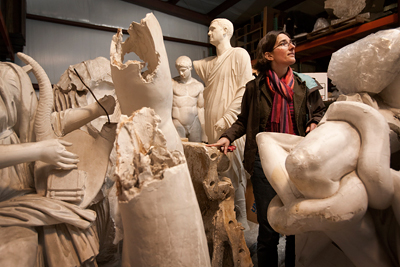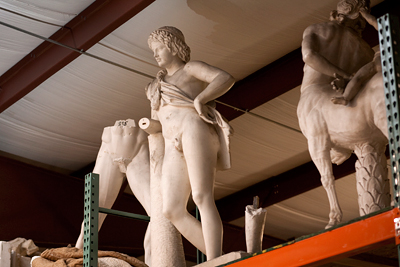Art historian fights to rescue historic plaster cast collection
By Jennifer Wholey


Strolling through Goldwin Smith Hall, you can't help but notice the plaster-cast statues and reliefs encased along the walls. However, the artwork on display is only but a fraction of the 500-piece collection. Where are these other pieces? In disarray and disrepair in a cramped warehouse near the Ithaca airport, relatively unknown and neglected.
Until now, that is, said art historian Annetta Alexandridis in a March 8 colloquium in Goldwin Smith Hall's Ruth Woolsey Findley Gallery of Art. She is working to restore the cast collection with help from a team of graduate and undergraduate students and the Department of Classics.
"It is high time to return to this precious resource the attention and care it deserves," said Alexandridis, assistant professor of art history. "The primary goal of our project is to document the remains and to collect all relevant information into a database. We want to rescue what can be saved and put on display as much as possible."
The collection of 19th century casts of ancient Grecian, Roman, Egyptian and medieval pieces was compiled in the 1890s with funds from trustee Henry Sage. Originally displayed in McGraw Hall, the pieces were moved into Goldwin Smith in 1906. But by the middle of the 20th century, Alexandridis said, the casts were seen as secondhand copies of first-rate originals, and so were mostly packed away.
"The question of copy and original is a central one," said Alexandridis.
The values of the casts have shifted over time, she said, depending on the wavering notions of authenticity and replica. In the past, the casts were valued as accessible models of the human form. However, their white color and original form without restorations can actually give a better outline of the whole form than an original statue, she said, which may get stained or renovated over the years.
Most strikingly, she said, the casts represent an accurate depiction of the original at the time the cast was made, minus the decay of the last 120 years. "The Cornell casts show objects in a state of preservation of the later 19th century; some of these originals are now lost or substantially altered due to wear, weathering, etc. In this case the casts bear more information than the original," making the copy more valuable than the original.
Catalina Lupu '10, a French and English major, said that she was shocked to hear about the underutilized potential of the casts. "Discovering that [the collection] was so underused made me incensed," Lupu said. "It would be nice if the cast collection could be restored and displayed somewhere."
The talk was presented as part of the Visual Cultures Colloquium, through the Department of History of Art and Visual Studies.
Jennifer Wholey '10 is a writer intern for the Cornell Chronicle.
Media Contact
Get Cornell news delivered right to your inbox.
Subscribe